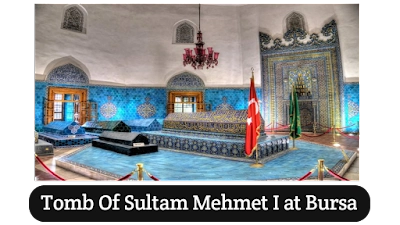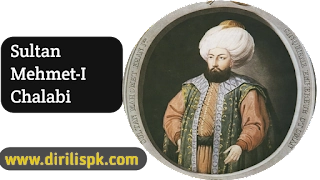Hi Friends today we’re going to tell you about the great man who reunited this fragmented Ottoman Empire. We told you that after the defeat in the battle of Ankara, Bayazid I was imprisoned in a cage by Timur Ling and humiliated. And sadly, Bayazid’s sons fought among themselves for ten years to seize the remnants of the empire. But then, The man came to power who ended the civil war and once again led this great empire to fulfill the historic dream of his ancestor. This person’s name was Sultan Muhammad I and history remembers him as Muhammad Chalabi. In today’s article, we will tell you about them.
According to 1389 or some traditions, Sultan Muhammad I was born in Bursa in 1387. His father was Bayazid I and his mother was Daulat Khatun. Sultan Muhammad I, who was of medium height, round face, raised eyebrows, white complexion, red cheeks, broad chest, strong body and agility, was blessed by Allah with great courage and bravery. He was a very good wrestler and it was a sign of his physical strength that he could pull the strings of many bows at once. During his reign, he took part in 24 wars and suffered about forty wounds.
After the defeat of Timur Ling, the Ottoman Empire entered a difficult period. For the next 20 years, the Ottoman Empire suffered severe devastation from the civil war. Dr. Akanje writes that the four sons of Bayazid I had thousands of supporters of their own and they fought among themselves for years. At the end of the Civil War, the Sultan’s youngest son, Muhammad I, defeated his brothers and became the sole heir to the Ottoman Empire in 1413. Sultan Mehmet I had to struggle for many more years to restore the Ottoman Empire to the limits it had under his father, Sultan Bayazid.
History Of Sultan Bayazid
Caroline Finkel writes that in 1416 Shah Rukh wrote a letter to Sultan Mehmet I and protested the killing of his brothers. So the answer of the Ottoman Sultan was, “Two kings cannot live in one country …” Our enemies who surround us are always looking for opportunities. Sultan Muhammad I, with his insight and foresight, overcame the civil war with great skill. And one by one, overcoming all his brothers, he became the sole ruler of this kingdom.
During his eight-year rule, he rebuilt the Ottoman Empire and made every effort to strengthen its pillars. Most of his reign was spent in this work and that is why some historians consider him the second founder of the Ottoman Empire.
What sets Sultan Muhammad I apart from other sultans is his understanding and forbearance. Whoever broke the law and refused to obey the Sultan, the Sultan acted patiently in his case. When the Amer of the Qarman region declared independence and was presented to the Sultan in chains the Sultan forgave him for swearing by the Holy Qur’an.
Then when he broke his oath again and was ready to revolt and get defeated again he appeared before the Sultan again but the Sultan apologized and forgave him again. The main goal of Sultan Muhammad’s policy was to rebuild the empire and strengthen it internally. That is why when the Sultan was defeated in the battle of Kleitboli, He returned some of the cities on the Black Sea coast to the Emir of Constantinople. He made an agreement with him and put an end to all tribulations. He led the uprisings in Asia and Europe and forced the subjugation of some of the emirates of Asia which had been instigated by Timur Ling. These emirates began to breathe new life into the Ottoman Empire’s obedience and friendship.

History Of Sultan Mehmet I Era Ottoman Empire
In the time of Sultan Muhammad, a man named Sheikh Badruddin Mahmud appeared who took the form of a Muslim cleric. He was in the army of Sultan Muhammad’s brother Musa and rose to the position of Qazi al-Askar, The highest position in the Ottoman Empire at that time. Musa ibn Yazid made him his special friend and thus he became the center of people’s beliefs. When Musa was assassinated by his brother Muhammad I, Badruddin was imprisoned in the Turkish city of Iznik. Here Badruddin began to invite people to his wrong and wicked religion. His false religion spread far and wide and his followers became very numerous. One of his preachers became very famous, who was called Pir Kaleja.
History of ottoman empire sultans
Even when the echo of this false belief reached the ears of Sultan Muhammad I, the Sultan sent an army to fight with him but this army was defeated. The Sultan then sent another army under the command of his special minister, Bayazid Pasha, who fought at Pir Kalija and defeated it at Qaraburno. But Sheikh Badruddin persisted in his misguidance. He thought that he would conquer the region.
Amir al-Akhlaq of Romania helped this heretic and foreigner. But Sultan Muhammad continued to pursue this enemy of Islam, which forced Badruddin to move to the area of Delhi and Orman, now in Bulgaria. Here he received European aid, and the revolt against Sultan Muhammad spread.
Sultan Muhammad I was a man of great intelligence and caution. He did everything with the utmost care and foresight. Therefore, instead of appointing another person as their leader against Badruddin and his followers, he took up arms and entered the field. The Sultan’s informants did their best to break into the ranks of the rebels and obtain important information, which led to the worst defeat of the rebels.
When Badruddin was presented to Sultan Muhammad, the Sultan asked him what was the reason? I see your face is yellow? Badruddin said: O my lord! When the sun begins to set, it turns yellow. The ulema of the kingdom debated with Badruddin freely and then he was sentenced to death according to Sharia law.
Sultan Muhammad I was also appreciative of poetry and the fine arts. He was the first sultan to send an annual gift in the service of the Emir of Makkah, which was called al-Sira. Actually, it was a specific amount that was sent to the Emir of Makkah to distribute among the poor and needy in Makkah and Madinah.
The Ottoman Sultan liked Muhammad I very much and called him a wrestler. And the reason was his great diligence and courage. In addition, he had a unique personality and great deeds due to which the Ottoman Empire was able to maintain its existence.
Then, due to his habits and qualities, courage, knowledge, friendliness and justice, the Sultan was able to be loved by his people and remembered by the title of Chalbi. It is an honorable title which is considered a symbol of dignity and bravery.
Ottoman Empire
Sultan Muhammad I was a lover of Islam, knowledge and jurists. That is why he moved Adria Naples, the city of worshipers, to the capital city of Brussa, which was considered the city of the jurists.
The Sultan was extremely creative, high-ranking, serious-minded, tolerant and had a unique policy towards friends and foes. Although some other rulers of the Ottoman dynasty are more famous than him, it is a fact that he is considered to be the greatest man of morals among the Ottoman sultans. Eastern and Greek historians have also acknowledged his high moral character. And Ottoman historians have given him the status of a great and capable ruler.
Which brought the Ottoman Empire’s oscillating ship to shore when it was badly damaged by Tatar attacks, civil wars and a storm of internal strife. When Sultan Muhammad I had put an end to all the tribulations that the Ottoman Empire faced, he focused on the internal order and stability of the country so that such incidents would not happen in the future.
But at the same time he became very ill and when he had no hope of surviving, he called his minister Bayazid Pasha and said: “I have appointed my son Murad as my deputy. Obey him and be as loyal to him as you have been to me.

Tomb Of Sultan Mehmed II At Bursa
I want you to bring Murad to me right away because I am not getting out of bed.” On May 26, 1421, Sultan Muhammad I passed away at the age of just 32 years. His shrine is located next to the Green Mosque in Bursa.
Thinking that the news of the Sultan’s demise would not cause any untoward incident, his two most important ministers, Ibrahim and Bayazid Pasha, agreed to keep the news hidden from the army until Murad II arrived. On the one hand, he spread the news in the army that the Sultan was ill and on the other hand, he urged the Sultan’s son to arrive quickly. Forty-one days later, when Murad Adria arrived in Naples, the ministers handed him the keys to the kingdom.
Thanks For Reading, If you like This article then please let us know with your kind feed back by comments or sharing this article.
